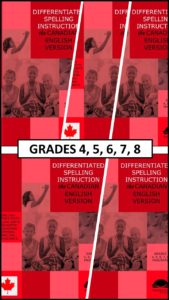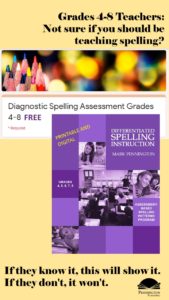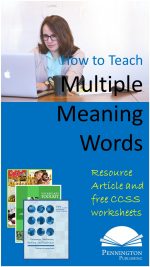Diagnostic Spelling Assessment
Diagnostic Spelling Assessment
Following are accurate and teachable spelling assessments and corresponding recording matrices to help teachers determine what students know and what they do not know. Each assessment is comprehensive, not a random sample, to enable teachers to teach to the results of each test item. The author’s spelling programs provide the resources for assessment-based whole class and individualized instruction. Click on the blue links for the assessment resources and check out the author’s programs, which provide the instructional resources to teach to each assessment.
Administer part or all of the Diagnostic Spelling Assessment (American English Version) test items, according to grade-level criteria.
- Grade 2: K-1 spelling patterns (#s 1‒41)
- Grade 3: K-3 spelling patterns (#s 1‒55)
- Grade 4: K-3 spelling patterns (#s 1‒64)
- Grade 5: K-4 spelling patterns (#s 1‒82)
- Grade 6: K-5 spelling patterns (#s 1‒100)
- Grade 7: K-6 spelling patterns(#s 1‒102)
Administer part or all of the Diagnostic Spelling Assessment (Canadian English Version) test items, according to grade-level criteria
- Grade 2: K-1 spelling patterns (#s 1‒41)
- Grade 3: K-3 spelling patterns (#s 1‒55)
- Grade 4: K-3 spelling patterns (#s 1‒64)
- Grade 5: K-4 spelling patterns (#s 1‒82)
- Grade 6: K-5 spelling patterns (#s 1‒100)
- Grade 7: K-6 spelling patterns(#s 1‒102)
- Grade 8: K-7 spelling patterns (#s 1‒106)
The test items are grouped by spelling patterns e.g., the four long /i/ spellings, to make posttest analysis simple. All spelling words are multi-syllabic to prevent students from identifying the words by “sight spellings” and to require recognition of the sound-spelling patterns within the context of syllables.
Assessment Formats
Choose the Diagnostic Spelling Assessment format which best suits your needs:
1. Printable Only: Teacher dictates the number of test items assigned to the grade levels, following the written administrative protocol. Students take the test on binder paper. Teacher corrects assessments according to directions and records spelling deficits on the Spelling Patterns Assessment Mastery Matrix.
American English Resources: Diagnostic Spelling Assessment teacher administration form; Spelling Patterns Assessment Mastery Matrix.
Canadian English Resources: Diagnostic Spelling Assessment teacher administration form; Spelling Patterns Assessment Mastery Matrix.
2. Audio and Printable: Teacher plays the “normal speed” Diagnostic Spelling Assessment audio file for grades 4, 5, and 6 students or the “quick version” Diagnostic Spelling Assessment audio file for grades 7 and 8 students. The audio file includes all administrative directions. Students take the test on binder paper. Teacher corrects assessments according to directions and records spelling deficits on the Spelling Patterns Assessment Mastery Matrix.
American English Resources: Diagnostic Spelling Assessment with the “normal speed” 22:38 audio file; Diagnostic Spelling Assessment with the “quick version 17:26 audio file; Spelling Patterns Assessment Matrix.
Canadian English Resources: Diagnostic Spelling Assessment with the “normal speed” 21:12 audio file; Diagnostic Spelling Assessment with the “quick version 18:53 audio file; Spelling Patterns Assessment Matrix. Audio files recorded by a Toronto teacher. Thanks!
3. Google Forms: Teacher shares either the Diagnostic Spelling Assessment Google Form with the “normal speed” for grades 4, 5, and 6 students or the form with the “quick version” for grades 7 and 8 students. Note that incorrect spellings with be accompanied by the Google red squiggly line indicating a spelling error. Students may be tempted to right click the word and select the correct spelling; however, if the teacher tells the students the purpose of the test and directs them not to self-correct, students will generally follow instructions. Telling students that they will receive the same amount of credit whether the spelling is accurate or not, and using the “quick version” audio also helps students avoid the temptation of cheating. Teacher uploads the students’ Google Forms into the Spelling Patterns Assessment Mastery Matrix Google Sheets.
American English Resources: Diagnostic Spelling Assessment Google Forms with the “normal speed” 22:38 audio file for grades 4, 5, and 6 students or the Diagnostic Spelling Assessment Google Forms with the “quick version: 17:26 audio file for grades 7 and 8 students; Spelling Patterns Assessment Mastery Matrix Google Sheets.
Canadian English Resources: Diagnostic Spelling Assessment Google Forms with the 21:10 “normal speed” audio file for grades 4, 5, and 6 students or the Diagnostic Spelling Assessment Google Forms with the 18:53 “quick version” audio file for grades 7 and 8 students; Spelling Patterns Assessment Mastery Matrix Google Sheets.

Spelling Programs for Canadians

American English












